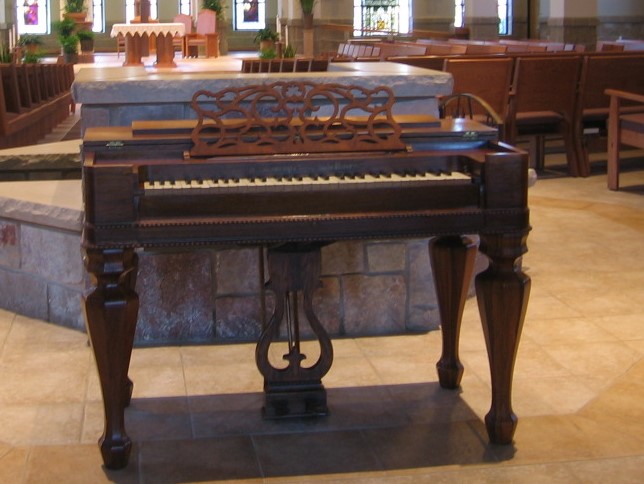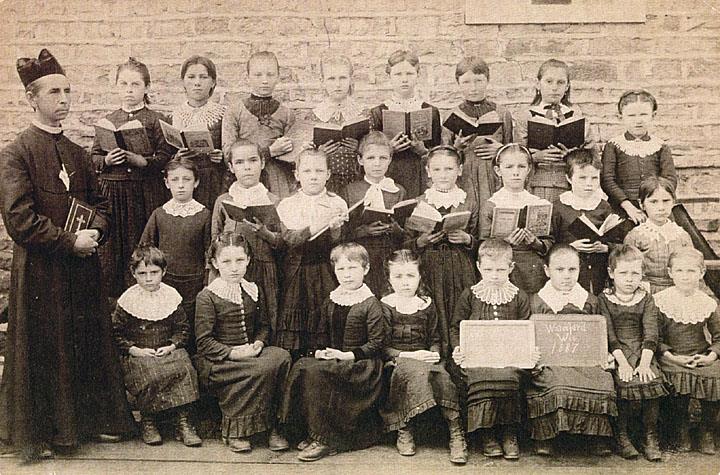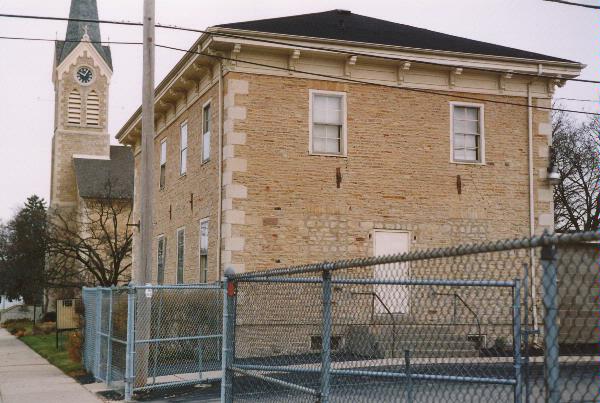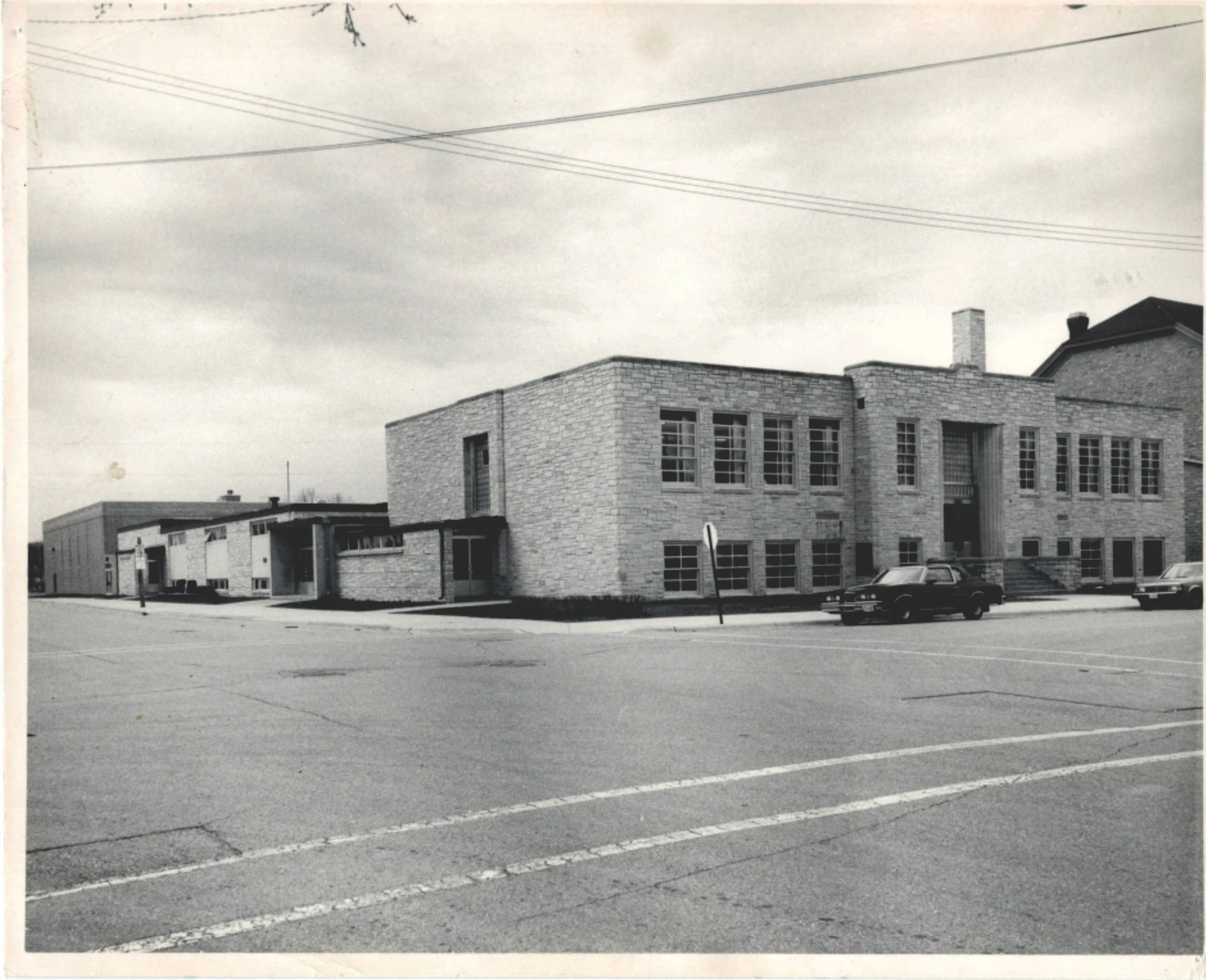OUR HISTORY
The earliest written records of Racine County acknowledge that the first European immigrants came to this area in 1836 when Wisconsin was only a Territory and this area was in the Town of Rochester. Records indicate that the name Waterford came from a small settlement of the same name near Albany, New York. Both the founder of the village, Sam Chapman, and its original land patent owner, Eliphalet Cramer, came from Waterford, New York. It was common to name new towns in the frontier after their original villages as it gave them a sense of continuity and fondness for their roots as they sought opportunities in a new land.
The settlement was already known as Waterford when it was first surveyed in 1842. Additions were quickly made in the subsequent years of 1843 to 1845. In 1847, a petition was sent to the Wisconsin Territorial Legislature by Sam Chapman and 22 other local inhabitants requesting to form the Town of Waterford.
In the very early years, most of the immigrants to Waterford were English. They continued to practice their Protestant faith using shared facilities until they could build their own churches. Around 1842, a few Irish and German Catholic families started to settle here.
Research information on the origins of St. Thomas Aquinas is somewhat anecdotal, which results in differences in dates and events that occurred in the 1830s and 1840s. The accuracy of the information depended on the quality of the author's memory. Once legal documents were established, the factual history becomes more evident.
According to an article, "In Existence Fifty Years", as published in the Racine Daily Journal, 11/26, 1901 Ibid1:
"The introduction of Catholicism in Waterford dates back to 1837 when a few Irish Catholics settled. It was in 1843 and 1844, however, when the first Irish priest (Fr. Morissey) visited there. In 1845, Fr. Henry Kendler of Burlington came and said the first Mass. Services were held at private houses and in the cooper shop of Charles Klunkefurt, (SE corner of Main and First St.), one of the very first Catholics. In 1846, Fr. Kundig visited the village and held meetings every three months in houses and barns. Fr. Schroedenback of Burlington was next in order, and at the close of that year, Fr. Weisbaner of Burlington; then in 1848, Fr. Koenig held services once a month and raised the first funds for the first Catholic Church."
According to "The Catholic Church in Wisconsin," by H.H. Heming, copyright 10/9/1896 Ibid2:
"It was during the month of June 1846, that divine services were held for the first time in Waterford. Fr. Kendeler conducting them in a newly erected cooper shop. From that time on, the holy sacrifice of the Mass was offered on weekdays every two or three months, generally in some dwelling or other building in the village. At about this time, also, Father Kundig, then of Franklin, made quarterly visits to Waterford, but on Sundays and festival days of obligation, the people attended services at Burlington. In the spring of 1847, Fr. Charles Schraudenbach came several times to Waterford, and in the fall of that year Fr. Wisbauer, resident pastor at Burlington, also made occasional visits to the place."
If local services were not held, the Catholics had to travel to Burlington to attend Mass at St. Sebastian's (now St. Mary's). Masses were said in Latin while the sermons were in German. Some attendees didn't understand either language, but they felt strongly about their Sunday obligation. Consider that our forefathers had to travel by horse and wagon or ox and wagon for five to eight miles in all sorts of weather and road conditions to attend Mass.

In 1848, Fr. Kundig, a traveling priest from Franklin, urged families to build a church of their own. Though poor and small in the beginning, the congregation of fewer than 50 families was up to the task. They raised money in five and ten-dollar subscriptions, which was quite an effort in those days, considering the meager resources of its members.
Debate persisted about whether it should be made of brick, stone or frame. Ultimately, it was decided to build with local stone. Should the sermons be in German or English? The Bishop insisted that it be an English-speaking church.
On May 10, 1849, Bishop Henni, on behalf of the Waterford Catholic Community, acquired four lots, 1, 2, 5 and 6, in block 29, which were located where St. Thomas School now stands. Samuel and Adeline Russ, then owners of a lot of the vacant land in Waterford, "donated" the lots for a sum of $2.00 or $5.00, depending on which legal document is referenced.
In 1849, building commenced and the church's name was given as St. Thomas Aquinas. In the first year, five feet of the exterior walls were completed by winter. In addition, they ran out of funding and more money was needed to continue. Gradually, more money was raised to purchase building materials and labor. Two years later, in the spring of 1851, the exterior was completed, and the first Mass was said on Corpus Christi Sunday, June 22, 1851. Based on the photo, the building size is estimated to be about 30’ by 40’.

In the winter of 1851-'52, Fr. Kundig opened a Catholic school with a donated room and an attendance of twelve children. A local farmer, Mr. Vessel Lansing acted as a teacher for a salary of eight dollars per month. Fr. Kundig organized two altar societies in the congregation, one for the German and one for the Irish members, through whose influence and exertions much was done towards decorating and beautifying the interior of the church. Immediately after Rev. M. Gernbauer was assigned as our first Pastor in 1852, he started work on building a Catholic school building. He made a frame addition to the church, half of which would be used as a school and the other half for a sacristy. Parish record-keeping of baptisms, confirmations, first communicants, matrimonial vows, and Christian burials began in 1851.
It would be over one year after the church was built before Bishop Henni, on behalf of St. Thomas Aquinas, purchased the remaining lots 3 and 4 for $150.00, completing the purchase of block 29.
"During 1853, the interior of the church was completed, school rooms made ready, and the cemetery established. On September 8, 1853, Bishop Henni made his first trip to Waterford to formally consecrate the church, bless the school and cemetery and administer the Sacrament of Confirmation." Excerpts from Ibid2.
The next ten years, from 1853-1863 saw the comings and goings of six pastors. Some only stayed two months. During this time period, Rev. Sanner had the framed addition to the church moved and a rectory built.
"Rev. S. Sanner requested the people to erect a suitable rectory beside the church for their pastor. The people saw the need for a proper dwelling for their pastor and acceded to his request. During the year of 1857, the material for the house was brought to the place, and the following year, the two-story stone building was built. In October 1860, Rev. Sanner was transferred to another place." Stories of Waterford and Its Busy Life, by Waterford Post, 1923 "During Father Sanner's incumbency, a two-story parsonage -32 feet x 24 feet - was erected at a cost of $1,000. This was in 1858". Ibid2

It was later occupied by the school sisters. Fr. Minderer, Fr. Seif, Fr. Stehle, and Fr. Schaudenbach also attended to members of the parish. Fr. Hess was the only one who remained for three years.

"Fr. Conrad assumed charge of the congregation on May 20, 1864. Under his administration, a new and commodious school-building, 46 feet x 30 feet and 30 feet high, was erected at a total cost of about $3,500. Besides two large school-rooms, this building contained a chapel and three rooms for the personal use of the Sisters of Notre Dame having the school in charge. (He did not think the lay teachers were devoted to teaching and thus had three Sisters of Notre Dame come to teach the children). Later on, a frame addition was built to the schoolhouse to serve as the kitchen for the Sisters." Excerpts from Ibid2.
But there were problems between the sisters and some people of the parish. Should the students be taught English or German? Consequently, in May 1867, the School Sisters resigned, returning to Milwaukee.
Then, Rev. DeBerge arrived. He also became discouraged and left after eight months. Then in 1867, Fr. Exel comes, but he also finds St. Thomas in disorder. The German immigrants and the Irish settlers could not agree. So the Irish organized their own parish in Dover and called it St. Mary's. Due to the disagreement between these two ethnic groups, Fr. Exel becomes discouraged and leaves.

Finally, things got better! In 1868, Fr. Joerger becomes the new pastor. The sisters of Notre Dame return and the school re-opens. "In the year 1870, Rev. J.M. Joerger bought a small organ for the church, paying $425 for the same." Ibid2. This organ was retired from the church and school in 1903, given as a wedding present to Joseph Harter and Anna Alby. It remained in their family until 2010, when it was returned to the parish and restored. Plans were made to use it again to celebrate the 165th anniversary of our church in 2016.

In 1873, once again, pastors only spent a short time at St. Thomas. During 1874, Rev. Schwaiger ministers to the faithful. In 1877, Fr. Schumacher calls for building a new church because the old church was becoming dilapidated and too small. There were eighty families in the parish.


In three years (1880), the cornerstone was blessed. The new Lannon Stone church was completed in 1881 with the blessing on October 4th. Due to an illness of Rev. Archbishop Heiss, the formal consecration was delayed until June 21, 1882, with the assistance of Pastor Fr. Schwinn and twenty-two other priests. In that same year, the high altar was erected with statues of St. Aloysius, St. Theresa, and St. Thomas Aquinas. When it was completed, it was free of all encumbrances. The church, including furniture and bells, though costing but $10,000 in cash, represents an actual value of about twice that amount. A lot of labor and many valuable presents were donated to the cause.
The school grows to one hundred students.
Fr. Schwinn's successor arrived in 1898. Fr. Weyer became the pastor for six years. He was responsible for many improvements to the premises. Fr. Albers followed, arriving in 1904, and he continued with needed improvements to the church, including electric lights.
The cemetery was surveyed and platted. Sidewalks were cemented from the cemetery to the church, but the work on the cemetery was not completed before Fr. Albers died, May 1, 1912. He is buried in our cemetery.
.jpg)
The new priest at St. Thomas was Fr. Pierron, who served longer than any pastor up to that time. He knew the church families referred to his predecessor as "Good Father Albers." So, money was collected to have a chapel erected over Fr. Alber's grave. The mason, Joseph Reesman, and the carpenter, Joseph Harter, did the work and a beautiful chapel now stands over the beloved pastor's gravesite. In 1914, the new "art glass" windows were donated and later installed in the church. These are the same stained-glass windows that were restored and are presently in our new 2007 House of Worship.
When WWI started in 1917, St. Thomas had thirty-four men and one woman leave Waterford to serve our country. The first to leave was Alfred Essman. He was the first and only one of St. Thomas parish to lose his life. The VFW Post is named in his honor.
On November 22, 1919, St. Thomas church caught fire due to a chimney over-heating. Fortunately, the church was saved and insurance covered the repairs. Fr. Pierron was still the Pastor, but had been ill for a year. Fr. Knackert covered his duties until Fr. Pierron retired in 1934. Then Fr. Bach arrives, but retires after a year due to illness. Fr. Pierron celebrated his Golden Jubilee in 1944 at St. Thomas Aquinas Church. However, he died in 1945 and was laid to rest in our cemetery.

 In 1935, a new pastor, Fr. Hertel, was welcomed to St. Thomas and served for twenty-eight years. In 1936, a building drive started for a new school. Mother of Perpetual Help Devotions started on Tuesday nights to pray for help in getting a new school. In 1941, the cornerstone was laid. The cost of the school was $55,000.
In 1935, a new pastor, Fr. Hertel, was welcomed to St. Thomas and served for twenty-eight years. In 1936, a building drive started for a new school. Mother of Perpetual Help Devotions started on Tuesday nights to pray for help in getting a new school. In 1941, the cornerstone was laid. The cost of the school was $55,000.

When WW II struck, fifty-eight parishioners went to serve and fight. Two of our finest parishioners who served our nation lost their lives fighting for freedom. They were Philip Bylewski and Theodore Mehring. In 1949, the inside of the 1880 church was renovated to prepare for the one-hundredth anniversary celebration.

During that time of Fr. Hertel's shepherding, the old rectory was sold and in 1954, a new larger rectory was built. The old rectory was built in 1901, but not without some opposition. The cost of the new building amounted to about $3,300. This is the same rectory we have today!

Because St. Thomas celebrated the Forty Hours Devotion each year, the rectory gave many of the visiting priests participating in the ceremony a place to spend the night. Additionally, St. Thomas has had assistant pastors over the years, and each had housing arrangements in the new rectory. Fr. Wagner, Fr. Fetherstone, Fr. Nichols and Fr. Walter was just a few of the assistants utilizing the rectory. In 1957, St. Thomas celebrated Fr. Hertel's fortieth anniversary of his ordination. Then just two years later, in 1959, ground was broken for an addition to the school. There were 397 students enrolled at that time. The new addition was dedicated in 1960. The enrollment grew in 1961 and 1962, to 423 and 497 students, respectively.

Fr. Hertel's sudden death in 1963 ended a very dedicated life that served his parishioners and the St. Thomas community unconditionally for 28 years. He was laid to rest in the family plot in Watertown, his hometown.
Fr. Skalitzy and Fr. Schaefer took charge of St. Thomas parish in 1963. There were 452 students enrolled in the school. In 1963, the Second Vatican Council allowed each country to say Mass in their vernacular, so English was introduced into the sacrifice of the Mass. In 1966, on the feast day of St.Thomas, a statue of St. Thomas Aquinas was erected in front of the church in memory of all the priests who had served the parish. This was also the year the clock and bells in the tower were stopped because of needed repairs. Assistant Pastor, Fr. Schaefer organized a Community Fund Drive to have the clock and bells electrified. Donations reached close to $6,000 and the time-piece was restarted.

The bells rang every fifteen minutes daily and for the Angelus at six in the morning, noon and six in the evening. On Sundays, they rang ten minutes before each Mass. It had been ten months since the bells had rung. The clock was lit at night. Fr. Schaefer will be remembered for his work with the youth of the parish and community. On April 23, 1967, the parish lost its pastor, Fr. Skalitzky, after a prolonged illness. He was laid to rest in Sun Prairie, his hometown.
In 1968, we received a new pastor, Fr. Uhen, and our new assistant pastor, Fr. Frieber. Fr. Uhen had a twenty-year pastorate at St. Thomas Aquinas and continued helping out as a retired priest in the city of Racine. The parish joined in celebrating Fr. Uhen's 25th anniversary of his ordination in May 1968. The church had 600 family units and 2,063 souls. School enrollment numbered 260 students.


The parish family was blessed when the Call to the priesthood was answered for the first time by one of our own parishioners. Ronald Gramza was ordained by Archbishop William Cousins on May 26, 1973. Fr. Gramza celebrated his first Mass at St. Thomas Aquinas. Under Fr. Uhen's leadership, the school gym was constructed with the cornerstone dated 1980. Later, it was made official that the gym was named the Uhen Center in honor of Fr. Uhen's pastoral serenity and athletic discipline. In 1988, Fr. Uhen retired from active priesthood.
Sometime around 1987, the Priest's Council of the Archdiocese of Milwaukee articulated and requested that a pastor of a parish should stay six years and then move on to another parish. The diocesan priests felt a pastor could get too attached to his flock. Another reason was that each pastor had to adhere to certain criteria during his stay and moving them more often makes them more accountable. There are a number of circumstances where a pastor can request an extension of his time at a given parish.
Fr. Tom Tierney embraced the pastorate of St. Thomas in 1988. He had a big heart and a strong singing voice. His passion was the celebration of the liturgy. Father was responsible for getting the parish back on-track as was required per the Vatican Guidelines, but sadly some parishioners did not fully comprehend the import of some of those changes. Nearly all the parishioners remember Father's great interest in baking. Everyone enjoyed his loaves of bread at the annual St. Thomas Country Fair that he personally baked to help make the Fair a great success. Also, Fr. Tom started the very successful annual eighth-grade spaghetti dinner that continued until the school closed in 2019. He left after three years. Fr. Tearney passed away shortly after he left St. Thomas.
 Fr. Dennis Van Beek came in 1991 to shepherd the flock at St. Thomas Aquinas. He was very happy whenever school was in session as he enjoyed teaching religion to the children. Father is best known for his brief, but very powerful and thought-provoking homilies at every daily Mass and all Sunday Masses. While at St. Thomas, he was made Dean of District Three, and therefore became Very Reverend Fr. Van Beek. This is the equivalent of what used to be known as Monsignor. Father had three goals that he wanted to accomplish; to teach, to sanctify, and to serve. He often said it was for the people to judge if he succeeded. He wanted his parishioners to become "Holy People." Father was really loved by all, and people felt a great loss when it was time for his departure after nine years as our favored Shepherd. During Father's pastorate at St. Thomas, the parish was blessed with our second parishioner's call to the Priesthood. Michael Erwin was ordained on May 16, 1998, by Archbishop Rembert Weakland. The celebration of Fr. Erwin's first Mass was at his home parish, St. Thomas Aquinas. Additionally, Joseph Hying and Carl Mahnke studied and were ordained permanent Deacons. Mr. Hying became Deacon Hying in 1992 and Mr. Mahnke became Deacon Mahnke in 1996.
Fr. Dennis Van Beek came in 1991 to shepherd the flock at St. Thomas Aquinas. He was very happy whenever school was in session as he enjoyed teaching religion to the children. Father is best known for his brief, but very powerful and thought-provoking homilies at every daily Mass and all Sunday Masses. While at St. Thomas, he was made Dean of District Three, and therefore became Very Reverend Fr. Van Beek. This is the equivalent of what used to be known as Monsignor. Father had three goals that he wanted to accomplish; to teach, to sanctify, and to serve. He often said it was for the people to judge if he succeeded. He wanted his parishioners to become "Holy People." Father was really loved by all, and people felt a great loss when it was time for his departure after nine years as our favored Shepherd. During Father's pastorate at St. Thomas, the parish was blessed with our second parishioner's call to the Priesthood. Michael Erwin was ordained on May 16, 1998, by Archbishop Rembert Weakland. The celebration of Fr. Erwin's first Mass was at his home parish, St. Thomas Aquinas. Additionally, Joseph Hying and Carl Mahnke studied and were ordained permanent Deacons. Mr. Hying became Deacon Hying in 1992 and Mr. Mahnke became Deacon Mahnke in 1996.
Fr. Edwin Kornath became our pastor in 2000. Father was very intelligent and had an unbelievable knowledge of the history of the saints. His homily was often the sharing of that knowledge. It was a special love of his. During his time at St. Thomas, the parish welcomed another parish member's call to the Deaconate. Jim Nichols was ordained Deacon Nichols on June 11, 2005. Under Fr. Kornath's leadership, our early planning started to investigate the financial impact, the structural size, and the location of our new House of Worship. After six years at St. Thomas, Fr. Kornath left in 2005.
 In June 2005, Father Gene Doda became our new pastor. He immediately took charge of the planning of the new church. In less than a year, on April 29, 2006, the parish witnessed Auxiliary Bishop Sklba and Fr. Gene, along with the architect and contractor, break ground for the new church. Then on Holy Saturday, April 7, 2007, Father Gene celebrated the first Mass in our beautifully constructed new church. We formally celebrated the dedication and consecration of our new House of Worship with Archbishop Timothy Dolan officiating on June 17, 2007.
In June 2005, Father Gene Doda became our new pastor. He immediately took charge of the planning of the new church. In less than a year, on April 29, 2006, the parish witnessed Auxiliary Bishop Sklba and Fr. Gene, along with the architect and contractor, break ground for the new church. Then on Holy Saturday, April 7, 2007, Father Gene celebrated the first Mass in our beautifully constructed new church. We formally celebrated the dedication and consecration of our new House of Worship with Archbishop Timothy Dolan officiating on June 17, 2007.
Following Fr. Gene's retirement in June 2018, Fr. Ed Tlucek was appointed by Archbishop Listecki as our new pastor. Fr. Ed's major undertaking was the merger of two worship sites (St. Thomas and St. Clare) under one banner “Wind & Water.” While the two parishes operate independently in their day-to-day operations, a collaborative effort was undertaken to share a priest and the sacramental elements for both churches.
In the Fall of 2023, Fr. Ed was called to a high administrative position within his National Franciscan Order. Rev. Johny Amaladasan, an Indian Pallottine priest and educator, was appointed interim Parochial Administrator of St. Clare and St. Thomas.
In June 2024, Archbishop Jerome Listecki appointed Fr. Steve K. Varghese as the Pastor of St. Clare and St. Thomas. Prior to this assignment, Fr. Steve was the pastor of St. Joseph and St. John Nepomuk parishes in Racine since 2012.
CLICK TO VIEW OUR PRIEST HISTORY
.jpg)

